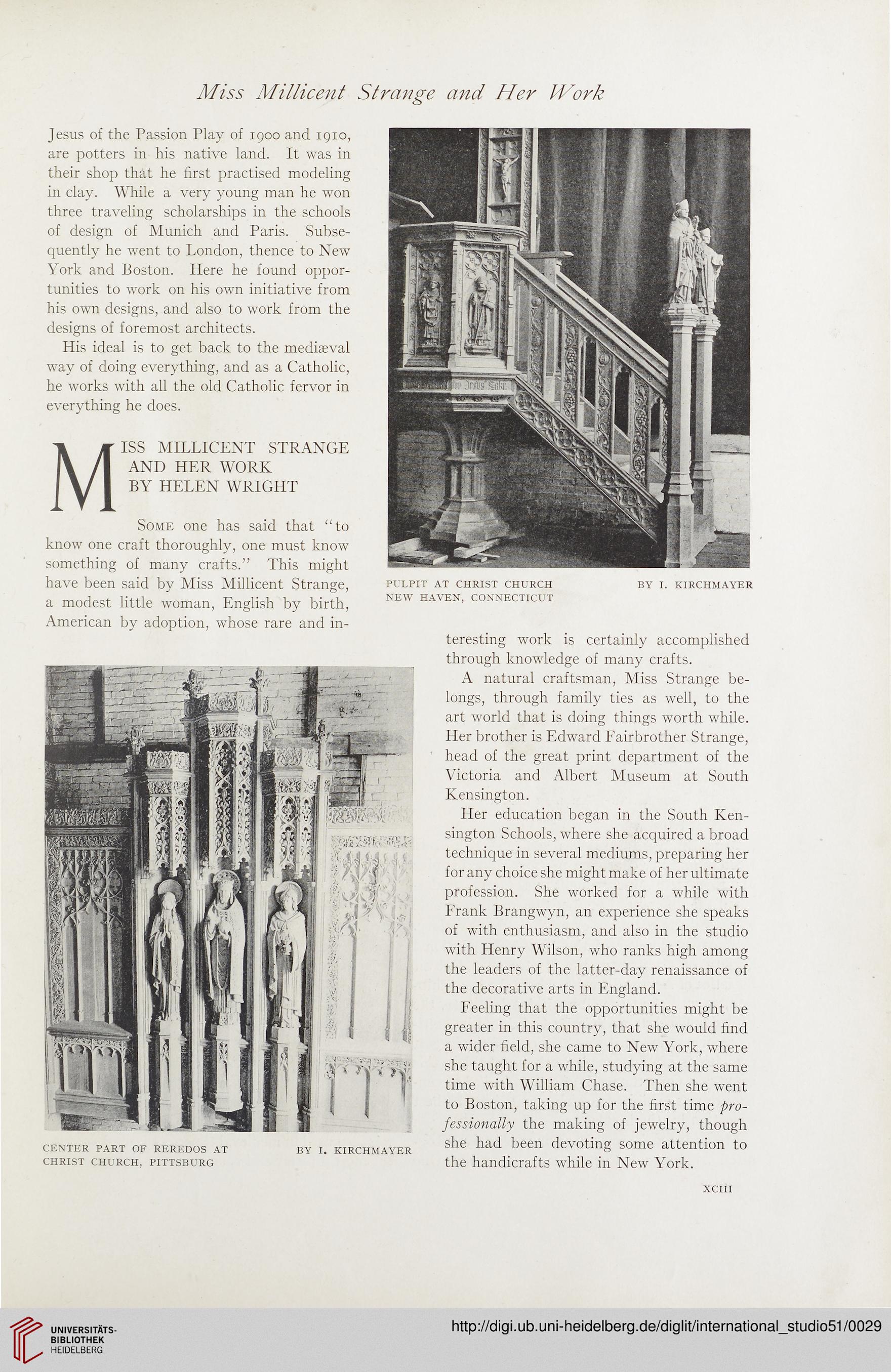Miss Millicent Strange and Her Work
Jesus of the Passion Play of 1900 and 1910,
are potters in his native land. It was in
their shop that he first practised modeling
in clay. While a very young man he won
three traveling scholarships in the schools
of design of Munich and Paris. Subse-
quently he went to London, thence to New
York and Boston. Here he found oppor-
tunities to work on his own initiative from
his own designs, and also to work from the
designs of foremost architects.
His ideal is to get back to the mediaeval
way of doing everything, and as a Catholic,
he works with all the old Catholic fervor in
everything he does.
MISS MILLICENT STRANGE
AND HER WORK
BY HELEN WRIGHT
Some one has said that “to
know one craft thoroughly, one must know
something of many crafts.” This might
have been said by Miss Millicent Strange,
a modest little woman, English by birth,
American by adoption, whose rare and in-
PULPIT AT CHRIST CHURCH BY I. KIRCHMAYER
NEW HAVEN, CONNECTICUT
teresting work is certainly accomplished
CENTER PART OF REREDOS AT BY I. KIRCHMAYER
CHRIST CHURCH, PITTSBURG
through knowledge of many crafts.
A natural craftsman, Miss Strange be-
longs, through family ties as well, to the
art world that is doing things worth while.
Her brother is Edward Fairbrother Strange,
head of the great print department of the
Victoria and Albert Museum at South
Kensington.
Her education began in the South Ken-
sington Schools, where she acquired a broad
technique in several mediums, preparing her
for any choice she might make of her ultimate
profession. She worked for a while with
Frank Brangwyn, an experience she speaks
of with enthusiasm, and also in the studio
with Henry Wilson, who ranks high among
the leaders of the latter-day renaissance of
the decorative arts in England.
Feeling that the opportunities might be
greater in this country, that she would find
a wider field, she came to New York, where
she taught for a while, studying at the same
time with William Chase. Then she went
to Boston, taking up for the first time pro-
fessionally the making of jewelry, though
she had been devoting some attention to
the handicrafts while in New York.
xcm
Jesus of the Passion Play of 1900 and 1910,
are potters in his native land. It was in
their shop that he first practised modeling
in clay. While a very young man he won
three traveling scholarships in the schools
of design of Munich and Paris. Subse-
quently he went to London, thence to New
York and Boston. Here he found oppor-
tunities to work on his own initiative from
his own designs, and also to work from the
designs of foremost architects.
His ideal is to get back to the mediaeval
way of doing everything, and as a Catholic,
he works with all the old Catholic fervor in
everything he does.
MISS MILLICENT STRANGE
AND HER WORK
BY HELEN WRIGHT
Some one has said that “to
know one craft thoroughly, one must know
something of many crafts.” This might
have been said by Miss Millicent Strange,
a modest little woman, English by birth,
American by adoption, whose rare and in-
PULPIT AT CHRIST CHURCH BY I. KIRCHMAYER
NEW HAVEN, CONNECTICUT
teresting work is certainly accomplished
CENTER PART OF REREDOS AT BY I. KIRCHMAYER
CHRIST CHURCH, PITTSBURG
through knowledge of many crafts.
A natural craftsman, Miss Strange be-
longs, through family ties as well, to the
art world that is doing things worth while.
Her brother is Edward Fairbrother Strange,
head of the great print department of the
Victoria and Albert Museum at South
Kensington.
Her education began in the South Ken-
sington Schools, where she acquired a broad
technique in several mediums, preparing her
for any choice she might make of her ultimate
profession. She worked for a while with
Frank Brangwyn, an experience she speaks
of with enthusiasm, and also in the studio
with Henry Wilson, who ranks high among
the leaders of the latter-day renaissance of
the decorative arts in England.
Feeling that the opportunities might be
greater in this country, that she would find
a wider field, she came to New York, where
she taught for a while, studying at the same
time with William Chase. Then she went
to Boston, taking up for the first time pro-
fessionally the making of jewelry, though
she had been devoting some attention to
the handicrafts while in New York.
xcm





